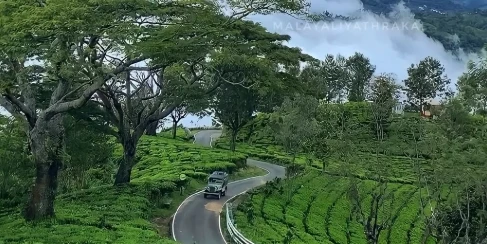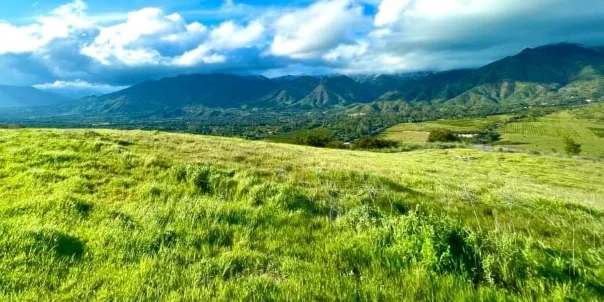
Into the Mist: Adventures Await in Wayanad
Situated within the emerald Western Ghats of Kerala, Wayanad is a serene hill district of mystical landscape, unparalleled diversity of flora and fauna, and heritage. Wayanad is one of the most scenic of Kerala's destinations at an elevation of between 700 and 2,100 meters above sea level, with a wonderful combination of nature, adventure, and history. With its rolling mist-shrouded hills, dense forests, rumbling waterfalls, and expansive tea and coffee plantations, this fairyland country is welcoming tourists seeking relaxation, exploration, and off-the-beaten-track adventure. Wayanad is beautified by a series of sites of scenic beauty and antiquity. The Edakkal Caves, a prehistoric cave with ancient rock inscriptions going back to 6,000 BC, take one through the history of human civilization. But another favourite destination is Wayanad Wildlife Sanctuary, which is a component of the Nilgiri Biosphere Reserve, and a mosaic blend of fauna and vegetation with elephants, tigers, deer, and endangered birdlife. Aesthetic and trekking activities shall be undertaken under dense forests by nature lovers as well as Soochipara Falls and Meenmutty Falls. The region is also dotted with calm lakes and beautiful locations. Pookode Lake, a forest lake, is perfect for boating and relaxation.

Or, Wayanad's summit point, Chembra, is a fascinating trek to the heart-shaped lake, perfect for adventure buffs. Banasura Sagar Dam, the largest earth dam in India, amidst gigantic hills and perfect for speedboat cruises and picnics is another scenic location. Wayanad possesses Kerala's indigenous culture and cultural heritage value. Indigenous villages are numerous in the district and they have preserved their traditional life and culture. Individuals reside in their distinctive culture in indigenous colonies and natives celebrate with tourists. Ayurvedic resort spas are renowned all over the world and are the latest trend here with cool treatment and therapy. Apart from being naturally and culturally rich, Wayanad is a culinary paradise. Kerala Malabari cuisine, bamboo rice, and tribal food all add to the destination. Tea, coffee, and spice plantations are being toured by tourists so that they get a feel and taste of the finest products of Kerala. With its near-perfect climate, ranging from hot summers to monsoons with mist and cold winters, Wayanad is a place that can be visited at any time of the year. Whether adventure traveller, nature enthusiast, or history buff, this hill station has something for all kinds of tourists, and hence it's a treasure that one needs to visit in Kerala.
History of Wayanad
Wayanad is rich in a stunning and mysterious history that spans from prehistoric ages. The region was populated more than 8,000 years ago, and the Edakkal Caves housed ancient human settlements. There were prehistoric rock inscriptions of 6,000 BC found in the caves to authenticate the presence of Neolithic settlements. The oldest residents were recorded by archaeologists as the Dravidian tribes that inhabited ancient South India. Wayanad belonged to the Kongu Nadu kingdom, which was ruled by several South Indian kingdoms such as the Kadambas, Gangas, and Vijayanagara Empire, in the early days. Then it was directly associated with Tamil Nadu and Karnataka since it was in the Western Ghats which gave the region a war and trade innovation hub route. From the 10th to 12th century, the Hoysala dynasty ruled Wayanad, followed by the Vijayanagara Empire ruled and controlled the area until the 16th century. Subsequently, Wayanad was a large majority of Malabar land belonging to the Zamorins of Calicut, who were the rulers of three areas. Zamorins controlled the spice trade and Wayanad contributed to the supply of black pepper, cardamom, and other precious spices.

In the 18th century, Wayanad was a battle between the Mysore Kingdom and the British East India Company. Tipu Sultan, a brilliant commander, fought many battles against the British here. The British captured Wayanad after Tipu Sultan's death and defeat in 1799 during the Fourth Anglo-Mysore War. Wayanad was part of the Madras Presidency afterwards. Wayanad was modernized by British colonial domination. The British established spice, tea, and coffee plantations changing the ecology as well as the economy. They built roads connecting Wayanad with other townships also enhancing trade as well as commerce. Tribals as well as state resources also became exploited under colonial governments. Since India attained independence in 1947, Kerala and Wayanad have been under the state of Madras, which later came to be merged in 1956 as an independent state. The district is currently a very significant agricultural area as well as a tourist area, which is widely known to provide green grasslands, wildlife sanctuaries, and tribesmen. Wayanad is a blend of nature, history, and culture today, its tribal past is lost but still vulnerable to modernisation. Its complex history, from prehistory inhabitation to colonial domination, has rendered it one of the most historically rich localities in Kerala.

Places to Visit Near Wayanad
Wayanad is surrounded by panoramic vistas, ancient ruins, and serene hideaways perfect for day trips or week-long vacations. Amongst the best places to visit around Wayanad are:
Bandipur National Park (80 km): Tourists' paradise, Karnataka's Bandipur National Park boasts of tigers, elephants, leopards, and deer. Bus or jeep safari inside the park offers spine-tingling experiences with wildlife in its natural surroundings.
Mudumalai National Park (90 km): Mudumalai in Tamil Nadu is a jeep safari and a Western Ghats wildlife corridor segment. It's famous for its thick faunal congregation, elephant sightings, and jungle safari in forests.
Kabini (95 km): Nature lover and photographer heaven, Kabini is famous for boat safaris on the Kabini River in relaxed mode, tigers, crocodiles, and elephants spotting.
Ooty (110 km): The "Queen of Hill Stations" Tamil Nadu's Ooty is famous for colonial romance, tea plantations, and Nilgiri Mountain Railway scenery. Must-visit places are Ooty Lake, Doddabetta Peak, and Botanical Gardens.
Nagarhole National Park (100 km): This Karnataka tiger reserve is a paradise for nature enthusiasts. It has jeep and boat safaris through which one can spot tigers, leopards, and elephants in huge herds.
Mysore (130 km: Mysore, Karnataka's cultural centre, is renowned for its enormous Mysore Palace, Temple on Chamundi Hill, and Brindavan Gardens. Perfect place for heritage and history lovers.
Bekal (130 km): Surrounded by the coastline of Kerala, Bekal is renowned for its ancient Bekal Fort and beach. A wonderful destination to witness the grandeur of the Kerala coast and ancient sites.
Coorg (115 km): Also referred to as Kodagu, Coorg is a scenic hill station in Karnataka, famous for coffee plantations, Abbey Falls, Raja's Seat, and Dubare Elephant Camp. Nature's haven and adventure activities.
Kozhikode (Calicut) (85 km): The ancient coastal city of Kerala, Kozhikode is famous for its beaches, historical monuments, and Malabar cuisine. Points of interest include Kozhikode Beach, Kappad Beach, and Pazhassi Raja Museum.
Silent Valley National Park (115 km): Kerala's UNESCO-announced biosphere reserve Silent Valley is a virgin forest where trekking, birdwatching, and experiencing virgin natural beauty are the right things.
How to Reach
Wayanad is relatively well accessible by road, rail, and air and may be readily connected directly with important Kerala, Karnataka, and Tamil Nadu towns. Wayanad lacks an airport and railway station and therefore the tourists must approach adjacent points of transhipment by way of road journey further.
By Air (nearest airport to Wayanad
The closest airport is Calicut International Airport (Kozhikode Airport) 90 km from here. Other airports nearby are:
Kannur International Airport (100 km)
Mysore Airport (120 km)
Coimbatore International Airport (190 km)
Taxis or buses from any of these airports can be utilized to reach Wayanad. Car drive distance in 3 hours from Calicut to Wayanad is also an option.
By Train (Nearest Railway Station to Wayanad)
There is no direct railway station in Wayanad but you can travel to the nearby railway stations and get a cab or bus facility. The nearest rail stations are:
Kozhikode (Calicut) Railway Station (90 km) – With enhanced transport facility.
Mysore Railway Station (120 km) – More convenient for tourists who travel here from Bangalore and Chennai.
Kannur Railway Station (110 km) – Tourist transport from Kerala coastal areas to here.
By Road (Optimum Road Route to Wayanad)
Wayanad is a simple destination by road, by state and by private buses from local towns. If you are an auto enthusiast, then Wayanad roads ought to offer hill, forest, and waterfall scenery.
Distances from Metropolitan Cities:
Bangalore – 280 km (6-7 hours) via NH275 & NH766
From Mysore – 120 km (3 hours) on NH766
From Calicut (Kozhikode) – 90 km (2.5-3 hours) via NH766
From Coimbatore – 190 km (5 hours) via NH181
From Kochi – 260 km (6-7 hours) via NH66 & NH766
Stay in Wayanad
Budget Homestays & Budget Hotels (₹800 – ₹3,000 per night)
Ideal for backpackers and budget travellers who are willing to spend on a low-cost stay with minimal amenities.
Zostel Wayanad – Budget hostel for backpackers with dorm and rooms.
Himadri Homestay – Homestay with reasonable hospitality and local food.
Bamboo Nest Wayanad – Nature Lodge with a serene atmosphere.
Hotel Haritagiri – Budget hotel with convenient reach.
Mid-Range Resorts & Hotels (₹3,000 – ₹7,000 per night)
Ideal for couples and families who require comfort and a good view but low budget.
Recommended Mid-Range Properties:
Banasura Hill Resort – View-based eco-resort.
Vythiri Village Resort is a well-rated resort with excellent service and cuisine.
Wayanad Silverwoods – Lake-front resort providing picturesque cottages.
The Wave Wayanad – Provides hill and forest room view with panoramic view.
Luxury Resorts & Private Villas (₹7,000 – ₹25,000 per night)
Best suited for couples, luxury travellers, and others who like to stay in luxurious facilities in luxury.
Best Luxury Stays:
The Serai Wayanad – Privately rented luxury pool villas.
CGH Earth Wayanad Wild – Luxury resort accommodation amidst nature.
Vythiri Resort – Inviting treehouse resort in the interior recesses of the forest.
Mount Xanadu Resort – Provides a sweeping view of the landscape atop a hill and world comforts.
Best Time to Visit Wayanad
Winter (October – March) → Ideal Time for Sightseeing & Adventure
Ideal for:
Trekking, wildlife safari, sightseeing, and honeymoon tour.
Temperature: 10°C – 25°C (Nice and Cool).
Why Visit?
The weather will be nice and cool, suitable for outdoor pursuits.
Soochipara Falls, Chembra Peak Trek, and Edakkal Caves will be best seen with nice and cool weather to explore.
Elephant, tiger, and deer spotting will be nice at Wayanad Wildlife Sanctuary.
Waterfalls at Meenmutty and Kanthanpara are in top-notch condition.
Summer (March-May) → Budget Travelers & Plantation Travels
Ideal for
Tea and coffee plantation tours, budget tours, and photography walks.
Temperature: 20°C – 36°C (Warm but Working).
Why to Visit?
Good morning and evening, afternoons are hot and humid.
Fewer tourists than in winter, therefore a good alternative for budget travellers.
Best season for boat trips in Pookode Lake and Banasura Sagar Dam.
Tea, coffee, and spice plantations are lush and ideal for day outings.
Monsoon (June – September) → Ideal for Nature Enthusiasts & Offbeat Travelers
Ideal for
Offbeat travellers, nature enthusiasts, and monsoon trekking.
Temperature: 17°C – 27°C (Rainy and Cool).
Why Go?
Wayanad becomes a green heaven of misty mountains and waterfalls pouring down.
The ideal time to visit Soochipara Falls, Meenmutty Falls, and Kuruvadweep Island.
Less touristy, so your peaceful and pocket-friendly stay.
Ideal for Ayurvedic treatment holidays as monsoon season is the optimal time for treatment.
Recent Blogs

Kotagiri's Secrets: Beyond the Tea Gardens
Apr 3, 2025

The Untamed Beauty of Bandeja Falls
Apr 3, 2025

Wayanad's Crown Jewel: Experiencing Chembra Peak
Apr 3, 2025
Related Blogs

Footprints on the Mountain Trails: Chikmagalur
Apr 3, 2025

A Journey to the Source: Exploring Coorg's Origins
Apr 3, 2025

The Ooty Experience: A Departure from Bangalore
Apr 3, 2025

About Us
Unleash adventure near Bangalore! From hills to caves, immerse in nature's thrill. Unforgettable memories await!
Quick Links
Contact Us
1st floor, 318, 8th Main Rd, Remco Bhel Layout, Ideal Homes Twp, RR Nagar, Bangalore - 560098